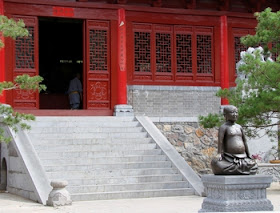The Shaolin Monastery and its famed Pagoda Forest were inscribed as a UNESCO World Heritage Site in 2010 as part of the "Historic Monuments of Dengfeng."
The first Shaolin Monastery abbot was Batuo (also called Fotuo or Buddhabhadra, not to be confused with Bodhidharma) a dhyana master who came to China from India in AD 464 to spread Buddhist teachings.
According to the Continued Biographies of Eminent Monks (AD 645) by Dàoxuān, the Shaolin Monastery was built on the north side of Shaoshi, the central peak of Mount Song, one of the Sacred Mountains of China, by Emperor Xiaowen of the Northern Wei Dynasty in AD 477. Yang Xuanzhi, in the Record of the Buddhist Monasteries of Luoyang (AD 547), and Li Xian, in the Ming Yitongzhi (AD 1461), concur with Daoxuan's location and attribution. The Jiaqing Chongxiu Yitongzhi (AD 1843) specifies that this monastery, located in the province of Henan, was built in the 20th year of theTàihé era of the Northern Wei Dynasty, that is, the monastery was built in AD 497.
Kangxi, the second Qing emperor, was a supporter of the Shaolin temple in Henan and he wrote the calligraphic inscriptions that hang over the Heavenly King Hall and the Buddha Hall to this day.
 | |
| shaolin-temple finger punching tree |

















































No comments:
Post a Comment